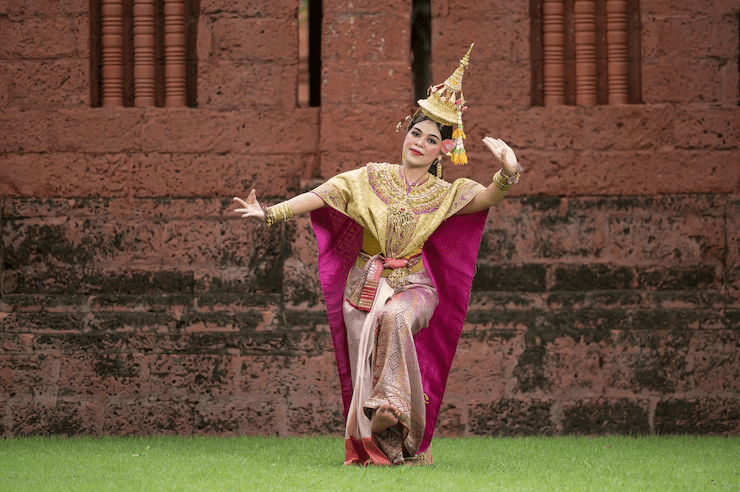Dance expresses the inner emotions
The mirth with which my four years old niece tiptoes on the floor, stretching her arms up above and swinging, keeps me wondering at the cause and expression of her ecstasy. Not only does she dance alone but implores others to join her mirth and shake the legs. In fact, what she does is the most primitive form of dancing.

Image Source: Freepik.com – Child Dancing In Ecstasy
Dance came in the human civilization as an expression of ecstasy and joy. Even some very ethnic tribal groups still practice such form of dance whenever there is a cause of merriment or celebration. Be it a good hunting or the full moon night when the surrounding is enchanting for celebration, or a marriage in the community, dance is a medium to celebrate the merry spirit and the joy. However, all societies whether the highly sophisticated ones or the tribal population over the world have found out their own style of dancing. They practice the same style through generations. The forms evolve into sub-types, but the basics remain the same.
Regional distinctions in dances
We have become acquainted with the various forms of dances that are the vehicle of expressions for different cultures. Distinctly we can separate the dances of one region from the other. For example, the western dances like Salsa, Ballet, Waltz is different from the Southeast Asian forms of dances like that of the Indians. Again, wearing a kimono and with a paper fan on hand, a Japanese damsel will mesmerise with her own form of dance which is distinctly different from an Egyptian or an African dancer. In whatever form it comes and is expressed, it is a great means of communication of the emotions that the dancer wants to express. In short, a dance weaves a story through the rhythmic expressions.

Image Source: Freepik.com – Dance of Thailand (Similar to India)
A storyteller, a form to express feelings for the divine
A dance is expressed best when the dancer acts out the emotions with subtle and minute expressions making it articulate as far as possible. The lithe footsteps, the rhythmic pose, the gestures, the facial expressions or mukh-abhinay, the body balance, the mudras, or the expressions of the palms etc., all built in the expressions through which any episode or event is conveyed to the audience.
All ancient civilizations consider dance as a divine mode of communication. Hence the temples of the Hindus and the Greeks, the pyramids, the ancient tombs in Africa, all has pictures or engravements of dancing figures. In fact, all Indians are aware of the ritual of worships that the Devadasis used to practice. To appease the deities, they offered prayers through their dances. Naturally the different dance forms cropped up in the different regions of the country which are still practiced and enriched every day. Thus, we have Bharatnatyam, Mohini Natyam, Kathakali, Kuchipudi, Odissi and what not. The Hindus even worship their beloved deity, lord Shiva as Nataraja – the king of dance. Even Lord Krishna is believed to have danced with his followers or gopis. Truly in India dance is considered as a divine medium of expression as in many ancient countries.

Image Source: Wikipedia – Uday Shankar & Pavlova (Radha Krishna)
The modern dances as spontaneous expressions of joy
Have you seen a couple dancing in a Tango or a Hip-hop, or have you simply watched those doing a break-dance or disco? All these dances have distinct languages. The languages of a dancer in joy expressed through a certain style. These dances need you to maintain a body rhythm and calls you to express your energetic spirit through the postures that come to perfection with regular practice. The start for a dancer happens through liking and passion but after some sessions, the postures become agile medium of expression of the joyous spirit that is in symphony with the mind, body, and spirit. The dances often come with music or songs and the dancer becomes naturally tuned to act out the drama in it.

Image Source: Freepik.com – Couple In A Rhythmic Tango
The best appealing forms comes from assimilation of various styles
The Master of Modern Dance forms have practiced different dance styles and formed their own assimilative genres that are most appealing to the audiences. In India such an exponent was Sri Uday Shankar – the Guru who had created a clan of dancers including Zohra Sehgal, Amala Shankar, Ana Pavlova, and many others. Though the Master has passed decades ago, a peep into the old videos make one realise the magic that dance creates and the wonderful communication that happens with the absorbing aesthetic mind of the audience.
While we remember Uday Shankar, we cannot fail to remember Martha Graham and Angela Isadora Duncan – the two ladies who taught the world about contemporary dance forms. Graham was rebellious to outdo the ballet form of dance with her own style. Isadora Duncan on the other hand created the fusion form with Greek, French and American dance styles. She stormed the stages with her expressive performances. She has depicted music, political movements and contemporary issues through her dance which won the heart of viewers throughout the Western world.

Image Source: PICRYL – Angela Isadora Duncan Performing
Off the track – Ancient tribes have funeral dances too
A decade back I was lucky to be a guest in the CII organised India-Ghana Confederation Meeting at Suresh Neotia Centre of Excellence. The delegates from Ghana which comprised of singers and dancers represented the meet. A young lady walked up the stage and said in her country there is the custom of funeral dance which she wanted to present. I presumed the expressions to be sombre. However, when she danced, we witnessed a most expressive and eloquent form that was rather on a positive note. It depicted a life after death and rebirth and the glorious journey to the heaven of the deceased. A little probing into the literature of the funeral dances of these African regions explains more. The logic behind such dance is that often the near ones of the deceased become too taken with grief. To divert their mind, the funeral dancers perform as the harbinger of hope.

Image Source: Wikipedia – Pallbearers’ Funeral Dance (Ghana)
So, on your next visit to a dance programme, try to comprehend the universal language that the art form will depict. If you dance to a group or to yourself, express the best of your spirit!





